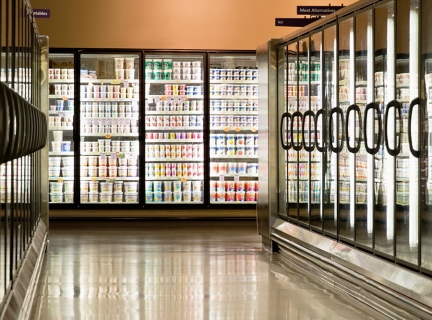
Businesses like grocery, liquor, and convenience stores depend on refrigeration systems. Some of these systems, however, can prove expensive to operate and harmful to the environment.
Equipment that leaks refrigerants will cost your business more. Leaks increase the amount of time a technician will need to be on-site to address issues with your equipment and add refrigerants back into the system. Equipment with reduced refrigerant levels also uses more electricity to operate.
Many refrigerants are rated to have high global warming potential and contribute to climate change when leaked. They create a compounding problem, as rising average temperatures in Minnesota will demand more out of refrigeration equipment, leading to higher costs.
Systems older than 15 years may still use chlorofluorocarbons, a class of gases that damage the protective ozone layer in the atmosphere. Given their high ozone depletion potential, chlorofluorocarbons have been phased out of production. They are sometimes still recharged with recovered or recycled gases, however, leading to more environmental impact.
Switch to low-global warming potential refrigerants
Using low-global warming potential refrigerants at your location could save you money and help protect the environment.
Replacing your current refrigerant with a low-global warming potential alternative may be possible, depending on the refrigeration equipment. Contact the manufacturer to determine if certified alternatives exist. If you use a third-party contractor to service refrigeration equipment, ask them to determine if lower global warming potential drop-in replacements are an option.
Are you planning to purchase new refrigerant-containing equipment? The EPA’s Significant New Alternatives Policy website has a list of natural and synthetic low-global warming potential options to guide you in your purchase. You can also ask your sales associate about low-global warming potential options.
Small business loans available
The MPCA offers 0% interest loans to small businesses to replace or retrofit refrigeration equipment with equipment that uses a lower global warming potential refrigerant.
Create a refrigerant management plan
Every business and organization should have a refrigerant management plan to lower costs and protect the environment. This is especially important for grocery, liquor, and convenience stores.
Assure equipment is clean, running efficiently, and that no leak goes undetected. Reference the plan when making decisions about repairs on existing equipment, as replacing the equipment might save money and help prevent climate change.
The plan should cover:
- procedures to inventory refrigerants
- how you will quickly detect leaks
- a policy requiring new equipment to include built-in leak detection features, when possible
- a policy requiring lower global warming potential refrigerants to be considered when purchasing new cooling equipment
- properly recovering refrigerant during service and disposal, even for small appliances; work with technicians certified by an EPA-approved course
Maintain a refrigerant inventory
Maintaining an inventory of the refrigerants used at your facilities can help you keep an eye on the true costs of leaks.
- keep records of the type and quantity of refrigerant used in each appliance
- update your refrigerant inventory during monthly equipment checks
- ask your service technician to maintain service logs for your equipment; keep these logs on-site for reference along with purchasing records that show the amounts of refrigerant you purchased
Check your refrigerant system monthly
- routine checks and cleaning can keep equipment running at peak efficiency; establish maintenance logs that track monthly inspections
- refer to the MnTAP checklist and guide for detailed instructions on how to check equipment
Detect and fix leaks
- Lower your facility’s climate impact by developing a leak detection program to help you quickly catch and fix leaks. You must repair leaks from appliances with a full charge of 50 pounds or more of ozone-depleting refrigerant when they exceed the applicable leak rate.
- Use tracking forms (see appendices) to trace fluctuations in refrigerant levels.
Working with refrigerants
People who service and dispose of vehicle air conditioners or appliances that contain refrigerants must be certified through an EPA-approved training program. Learn more:
Additional resources
- MnTAP refrigeration
- EPA GreenChill
- Transitioning to low-GWP alternatives in residential and light commercial air conditioning
- Transitioning to low-GWP alternatives in passenger vehicle air conditioners
- Transitioning to low-GWP alternatives in commercial refrigeration
- Tool to calculate greenhouse gas emissions from refrigerant leaks